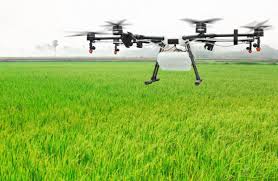Drones a tool for efficient agriculture: a high-tech future
INTRODUCTION

[Drone sale UK] The management of the water resources of a country
depends, to a great extent, on the knowledge of the existing hydrological
basins, their potential, and the adequate management of the water surpluses. The
current technological development and of the last decades lead us to use the
products of the remote sensors (satellite and radar) in the management of the
water and the agriculture, for example, in the administration and planning of
the activities of forecast and control of the floods, floods, and droughts closely
linked to agricultural production. Today, water managers use this spatial
information to prevent or quantify all kinds of parameters related to water
use, droughts, floods, etc. Likewise, the use of unmanned aerial vehicles
(UAV or DRONE) is becoming more frequent, based on the complexity that
natural systems have for their study since in most cases we must carry out
monitoring, sampling, etc., which are very complicated or high risk. Therefore,
its use is fully justified. The designation UAV is linked to military
vehicles and DRONE to unmanned vehicles for civil operations.
From the 19th century to the present, its evolution and emergence
have been taking place. There are a series of historical events and
relevant aspects that little by little have been shaping what today we know as
a new lethal way of killing from a distance and that has also led to the growth
of devices or unmanned units as a powerful technology developed as well. in the
civil sector, specifically in the field of precision agriculture. The
first uses were for military purposes, and one of the first recorded was that
of the Austrians in July 1849, after around two hundred bomb-mounted unmanned
hot air balloons were launched in the city of Venice. [Theragun UK] Drones, or unmanned
aerial vehicles, have been used by the military since World War I for remote
surveillance. There are estimates that 80-90% of the drone market in the
next decade will be used in agriculture.
In this review work, we seek to establish the advances in the use
of drones as a tool for efficient, precision agriculture, and to determine what
will be the future of that technology that comes to us in this line of
research.
METHODOLOGY
According to the characteristics of
the case reviewed, methodologically we established interrelationships, where
academic studies and official material in the public domain of academic,
technological and scientific institutions are consulted. [Segways]Under this
methodology we seek to explain the current and future advances of the use of
drones in precision agriculture with high efficiency. There is
documentation that was analyzed and schematized to be reported in this work and
at the same time served to establish the discussion and conclusions about the
use of drones as a tool for efficient agriculture.
Technology currently available for
agriculture
In the international market, there are various types of drones for agriculture. The most widely used in this field are the multirotor-quadcopter (flight time of 30 minutes and coverage per flight of 65 ha) and the fixed-wing (flight time of 30 to 90 minutes and coverage per flight of 120 to 3,800 ha). [Buy Ebike UK] An important aspect is the sensors used. Sensors that capture red-green-blue (RGB) and near-infrared (NIR) images have not necessarily been produced and calibrated for agriculture. The photographs that are taken must be geolocated, in such a way that they can be located exactly to be superimposed and with them form the map of the plantation. These types of sensors are found in Go-Pro, Canon, Sony, and every other brand of camera. Agricultural-type cameras have specialized filters that make them more expensive. Examples of specialized cameras for agriculture are the Micasense Red-Edge and Parrot Sequoia. These cameras are lightweight and designed specifically for the power of drones. Another important aspect is the location on the ground: drones have built-in GPS that gives the location in flight. The currently manageable precision in this equipment is +/- 3 m.
Written and published by:




Comments
Post a Comment